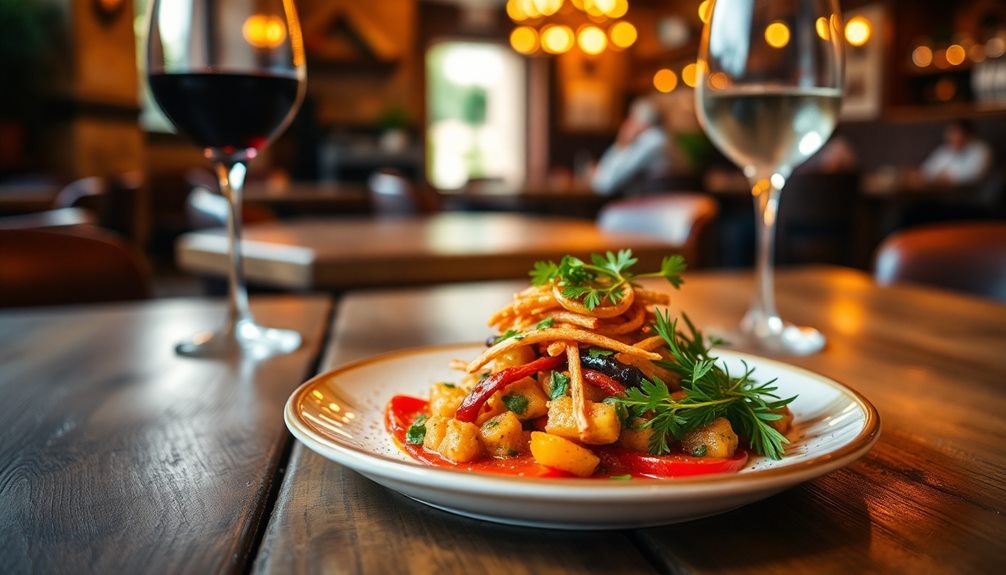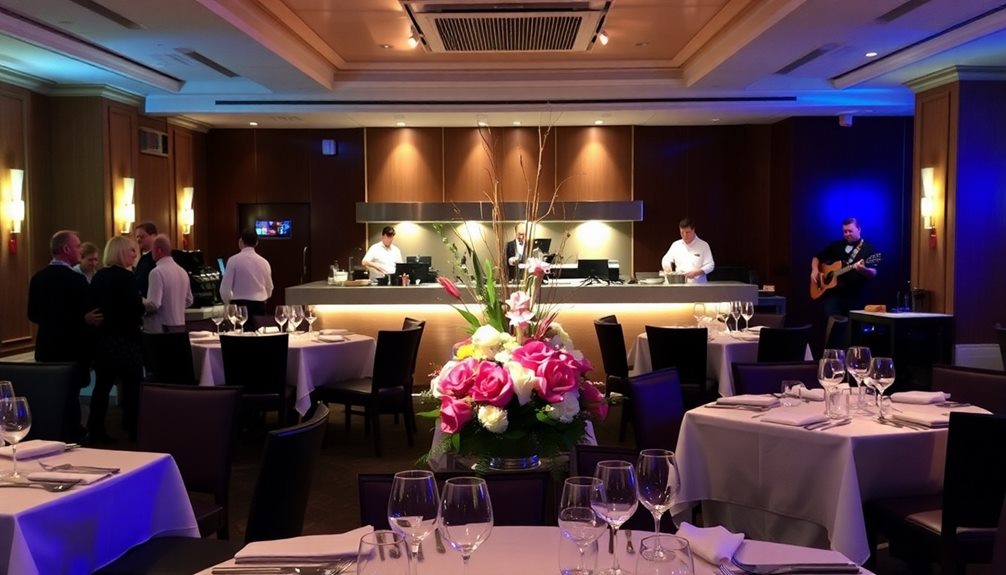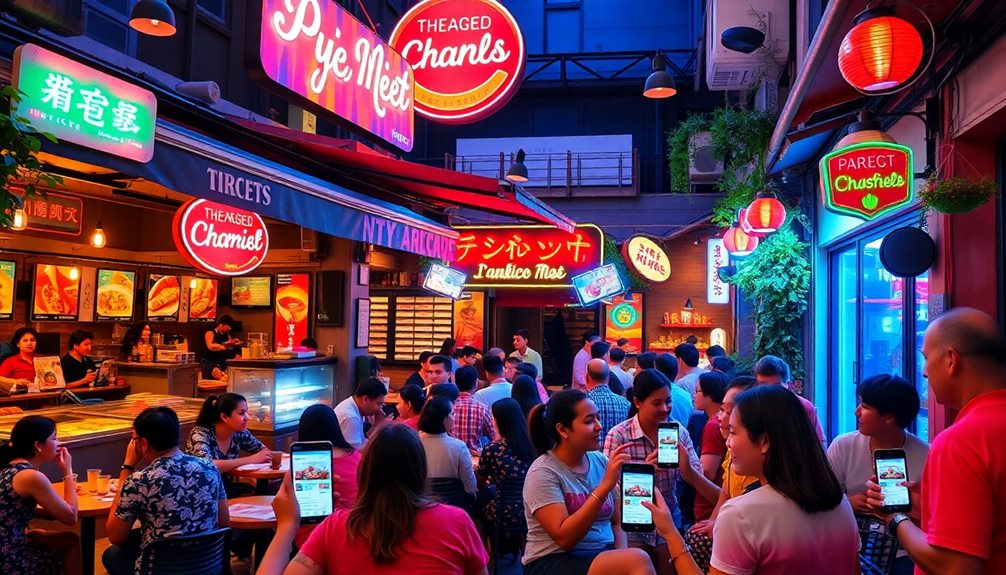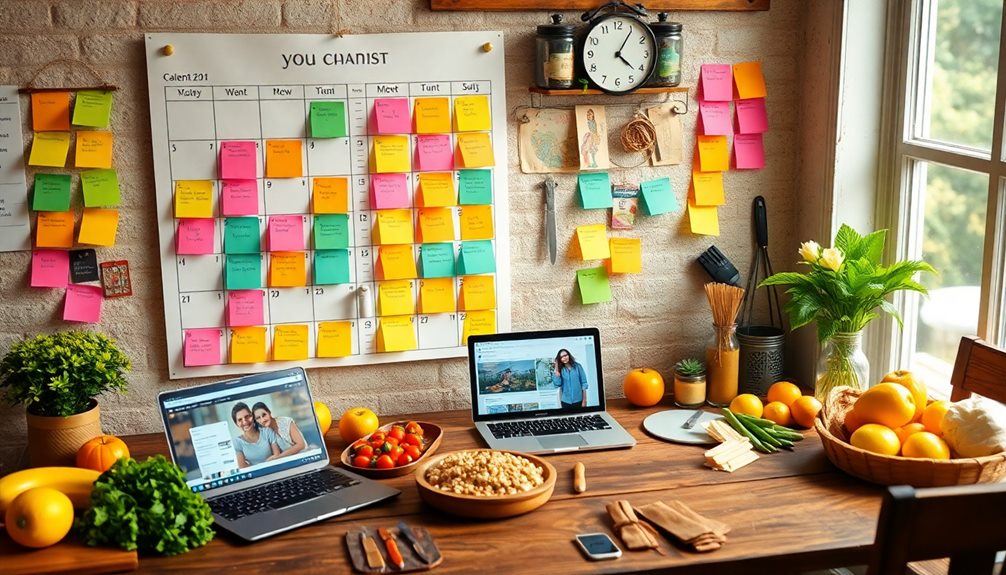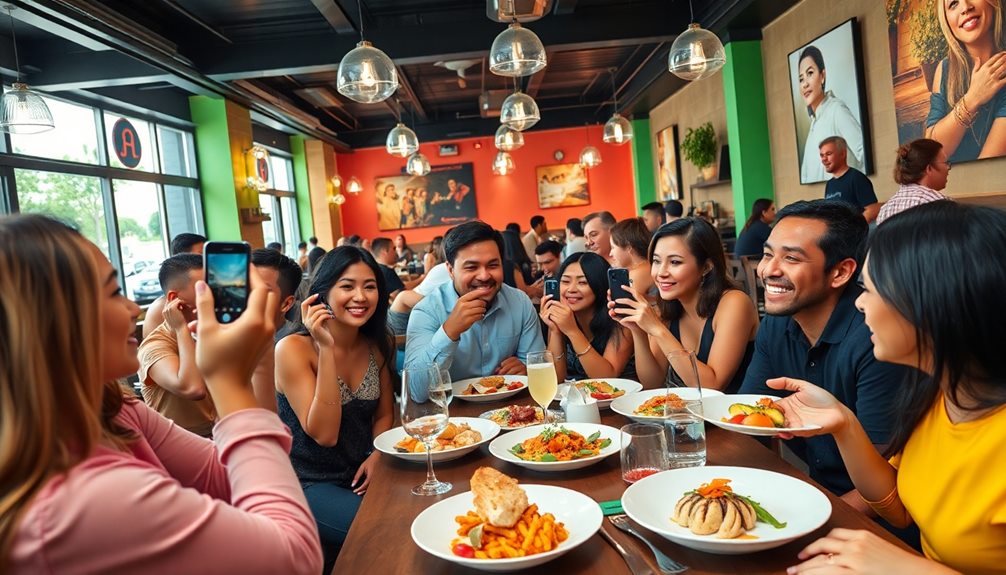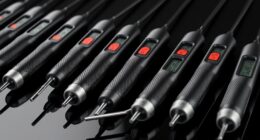To elevate your restaurant photography, focus on natural light. Shoot near windows or during golden hour for soft, inviting images. Use the rule of thirds to create balanced compositions and experiment with different angles. Capture multiple shots for variety. Incorporate fresh ingredients and vibrant garnishes for stunning food styling. Don't forget to include human elements, like diners enjoying their meals, to add emotional depth. Finally, take your time with editing to enhance color and focus. These tips can make your dishes irresistible, and there's plenty more to explore to perfect your skills.
Key Takeaways
- Utilize natural light by shooting near windows or during golden hour for soft, flattering images.
- Apply the rule of thirds and maintain negative space for balanced and impactful compositions.
- Capture multiple angles and perspectives to provide variety and reduce reshoots.
- Incorporate vibrant garnishes and fresh ingredients for visually appealing food styling.
- Edit photos for brightness and color correction, ensuring consistency to reinforce brand identity.
Importance of Food Photography
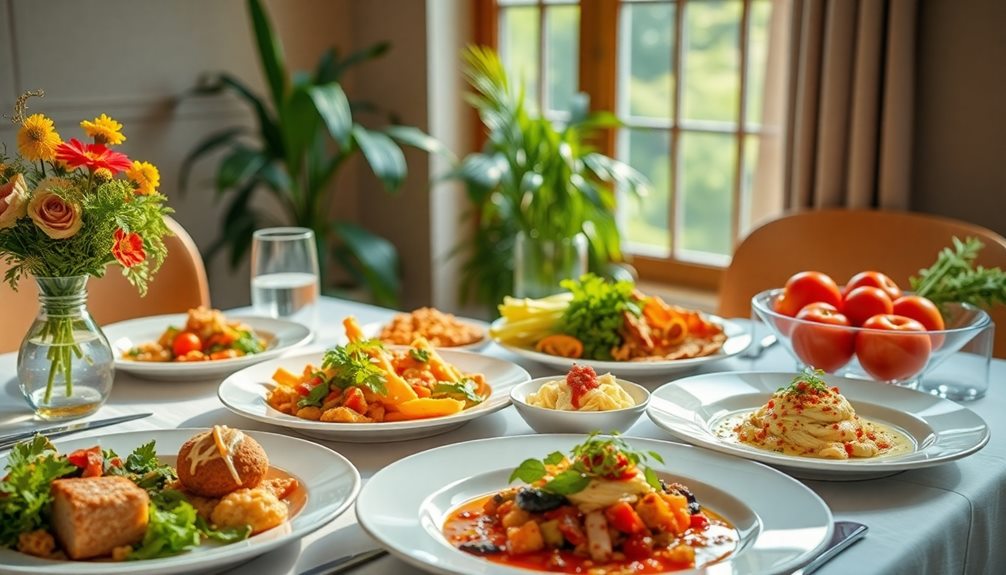
When you think about choosing a restaurant, the images you see can make all the difference. High-quality food photography plays an essential role in restaurant marketing, influencing your dining decisions markedly.
Studies show that 60% of consumers are drawn to restaurants with appealing visuals, so showcasing your dishes through effective food styling is vital.
Using natural lighting can enhance your food photos, making them look more appetizing. If you want to stand out on social media, remember that engaging images generate 94% more views than text-based posts. A professional photographer can elevate your brand image, ensuring your food looks irresistible.
Moreover, the quality of your food imagery directly impacts purchasing decisions, as 67% of consumers say it influences their choices. By investing in food photography tips, you can create visually stunning content that resonates with your audience.
This not only leads to higher customer engagement but also increases the likelihood of your posts being shared—up to 40 times more on social platforms! In a world driven by visuals, great food photography is your secret weapon for attracting customers and building a strong online presence.
Essential Photography Techniques
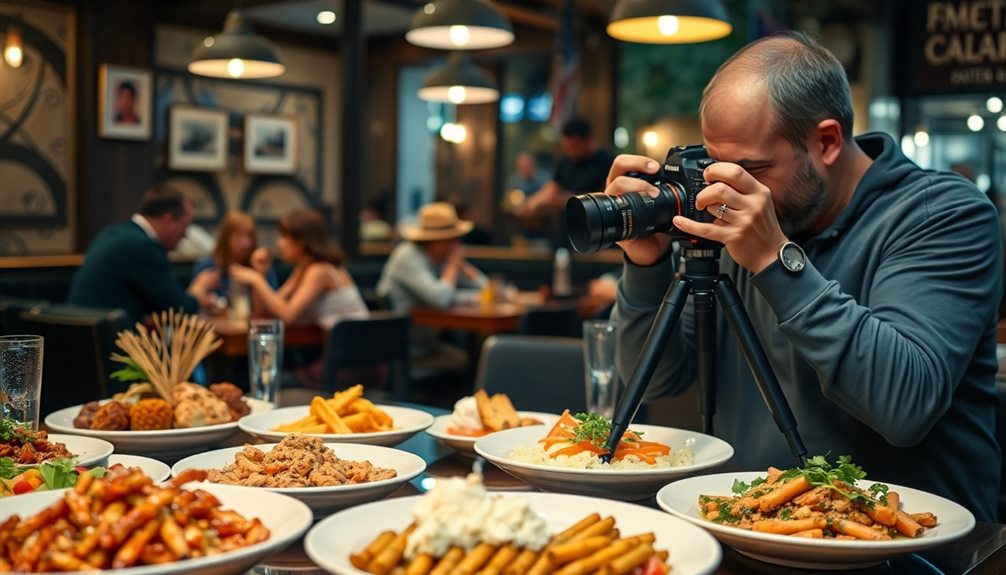
To capture stunning food images, mastering natural light is key, so position yourself near windows or shoot during the golden hour.
Many restaurants, especially those that feature live music, often provide beautiful ambiance that complements your food photography.
You'll also want to pay attention to composition and angles, using techniques like the rule of thirds and experimenting with different perspectives.
This approach not only enhances the visual appeal but also guarantees your dishes stand out beautifully.
Mastering Natural Light
Mastering natural light is essential for capturing stunning food photography that draws attention and whets appetites. To achieve the best results, utilize indirect natural light by positioning your setup near windows. This helps avoid harsh shadows and bright spots, enhancing the food's appearance considerably.
Additionally, maintaining a clean environment around your setup can prevent unwanted dust particles from detracting from the food's visual appeal, much like how air purifier maintenance improves air quality in a space.
Consider these tips to elevate your food photography:
- Shoot during the golden hour for soft, flattering light that enhances colors.
- Experiment with angles; backlighting creates a lovely glow, while side lighting adds depth.
- Use reflectors to bounce natural light onto your subject, filling in shadows for a balanced exposure.
Avoid using flash in food photography, as it can create harsh shadows and distort natural colors, leading to unappealing images.
Composition and Angles
Composition and angles play an essential role in elevating your food photography to the next level. Start by applying the rule of thirds to create balanced compositions that enhance visual interest. This technique helps draw the viewer's eye directly to the food.
Experiment with various angles; for flat dishes, overhead shots work well, while 45-degree angles are perfect for layered foods, providing a dynamic perspective.
Incorporate leading lines into your composition to guide the viewer's attention toward the main subject, making your image more engaging. Don't forget about negative space—maintaining it around the food emphasizes the dish and creates a clean, distraction-free look, allowing the culinary creation to shine.
Capture multiple shots from different perspectives to provide variety in your portfolio. This approach is especially useful for marketing applications across platforms and decreases the likelihood of needing future reshoots.
Mastering Lighting Strategies
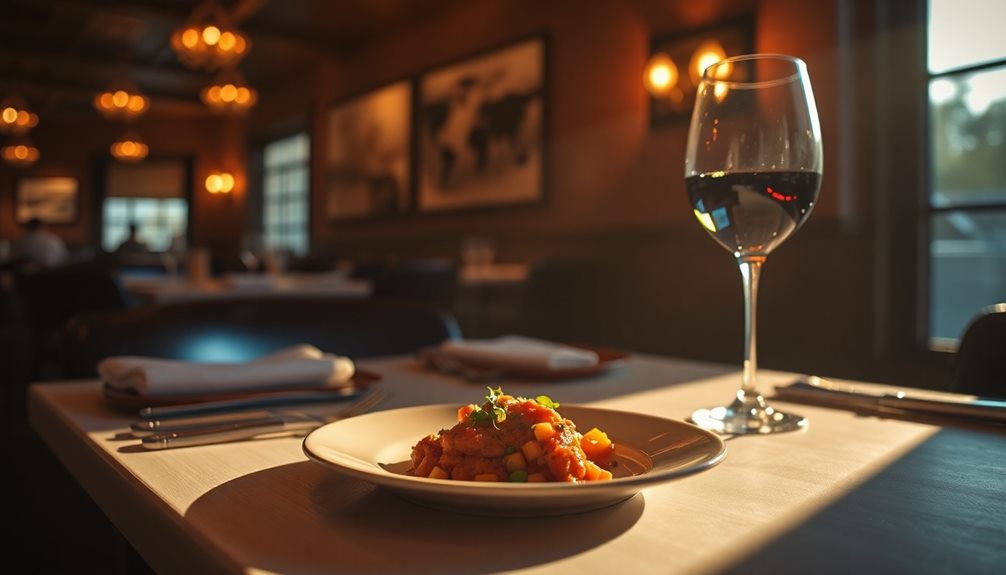
To capture mouthwatering food photos, mastering lighting strategies is key.
You can enhance your shots by using natural light, experimenting with artificial lighting setups, and applying diffusion and reflection techniques.
Each method can help you create stunning, well-lit images that showcase your culinary creations beautifully.
Natural Light Utilization
When it comes to restaurant photography, leveraging natural light can transform your food shots into stunning visuals. Position your setup near windows to harness soft, diffused illumination that enhances your dishes' appearance and minimizes harsh shadows.
The golden hour, shortly after sunrise or before sunset, provides the best natural light for food photography, creating a warm and inviting atmosphere. Utilizing techniques from the art of decluttering strategies can also help you create a clean and appealing backdrop for your dishes.
Here are some tips to maximize your natural light usage:
- Avoid direct sunlight: It can create bright spots and strong shadows. Aim for indirect light for balanced exposure.
- Use reflectors: These can bounce natural light onto your food, reducing shadows and adding dimension.
- Experiment with angles: Finding the ideal position allows you to take full advantage of the available natural light for each dish.
Don't shy away from experimenting with different angles and distances. You might find that a dark and moody shot works well with certain dishes, while others shine in a brighter setting.
Mastering natural light utilization will elevate your food photography and create mouthwatering images that draw customers in.
Artificial Lighting Techniques
Mastering artificial lighting techniques can greatly elevate your restaurant photography. To start, use softboxes or umbrellas to diffuse your artificial lighting. This setup creates a soft glow, reducing harsh shadows that can distract from your food.
Position your lights at a 45-degree angle to mimic natural light, adding depth and dimension to your images. Experimenting with color temperature is also key. Adjusting the settings on your artificial lights can help guarantee the food appears true to color. Warmer lights often enhance the appeal of certain dishes, making them look more inviting.
Incorporate reflectors to bounce light back onto the food. This technique fills in shadows and creates a more balanced exposure, ensuring every detail is captured beautifully.
Avoid using direct flash, as it tends to create unflattering highlights and can wash out the colors of your dishes. Instead, rely on your carefully positioned softboxes and reflectors to achieve that stunning, professional look.
With these techniques, your restaurant photography will become more vibrant and appetizing, drawing customers in with every shot.
Diffusion and Reflection Methods
Effective lighting strategies can make a significant difference in your restaurant photography. Mastering diffusion and reflection methods will elevate your food images by softening harsh light and enhancing colors.
Here are some key techniques to contemplate:
- Use diffusion methods like white bedsheets or professional diffusers to soften direct sunlight, reducing unwanted shadows and highlighting textures.
- Incorporate reflectors (silver or gold) to bounce light onto your dishes, enhancing highlights and bringing out vibrant colors from various angles.
- Take advantage of natural light during the golden hour for soft, warm illumination that minimizes shadows and creates inviting images.
Combining natural light with artificial sources like softboxes or LED panels gives you control over your lighting environment, ensuring consistent exposure and color balance.
Experiment with the placement of your diffusers and reflectors relative to the light source to create different moods in your photographs.
Composition for Impact
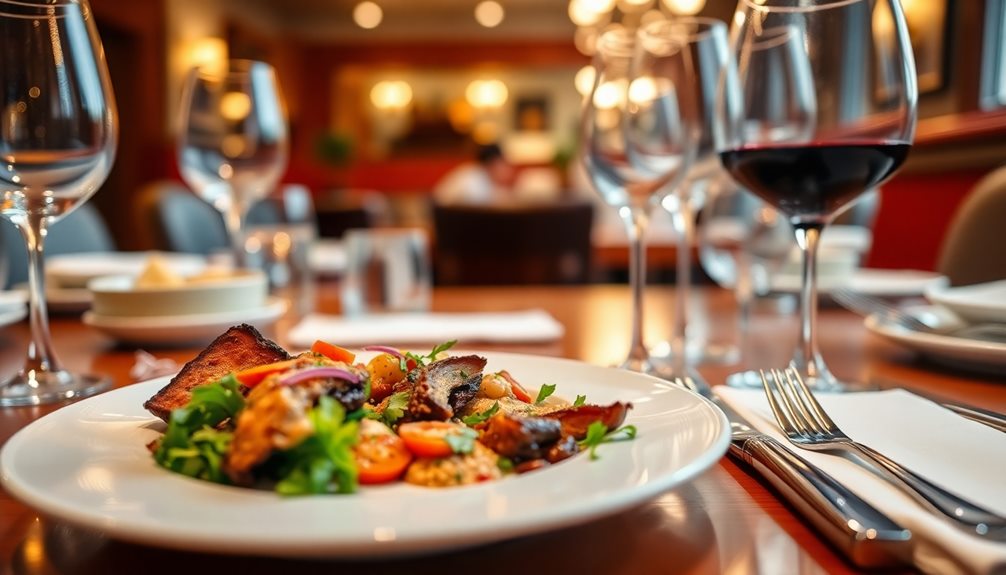
To create impactful restaurant photography, understanding composition is essential, as it can greatly enhance the viewer's experience.
Start by utilizing the rule of thirds; divide your frame into a 3×3 grid and place your main subject along the lines or at their intersections. This creates a more dynamic composition. Incorporate leading lines—like table edges or utensils—to guide the viewer's eye toward the food, enhancing the overall visual flow.
Don't underestimate the power of negative space. Leaving empty areas around your dish draws attention to it and reduces distractions.
Experiment with various angles: use an overhead shot for flat dishes and a 45-degree angle for layered items. This can showcase the food's texture and details more compellingly.
Lastly, aim for balance and harmony within your composition. Thoughtfully arrange elements in the frame to guarantee that no single part overwhelms the others. A cohesive visual story makes your photography more engaging.
Recommended Equipment
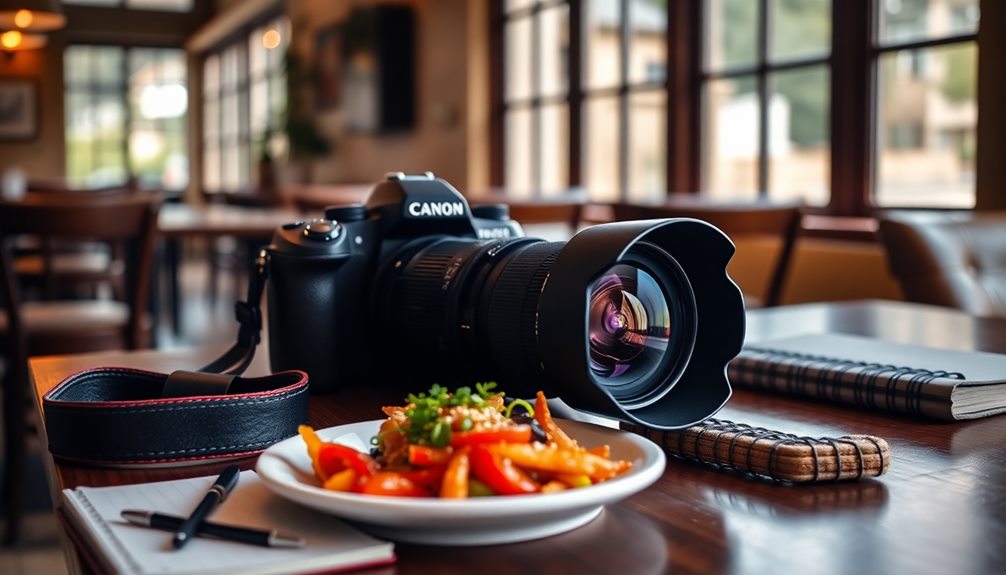
When diving into restaurant photography, having the right equipment can make all the difference in capturing mouthwatering images. Start with a high-quality DSLR or mirrorless camera. These cameras offer advanced features and interchangeable lenses, giving you the flexibility and control you need for stunning food photography.
Next, invest in prime lenses, such as a 50mm or 85mm. These lenses provide sharp images and a shallow depth of field, allowing you to beautifully isolate your subject.
Don't forget a sturdy tripod! It's essential for stability, especially in low-light conditions. A tripod enables longer exposure times without blur, ensuring that your food looks as delicious as it tastes.
To maximize your use of natural light, consider using light reflectors. They bounce light onto your subject, reducing shadows and enhancing your image quality.
Finally, think about tethered shooting. Using high-quality cords lets you review images in real-time on a laptop, enabling immediate adjustments and client feedback during the shoot.
Here's a quick recap of recommended equipment:
- DSLR or mirrorless camera
- Prime lenses (50mm or 85mm)
- Tripod for stability
Food Styling Tips
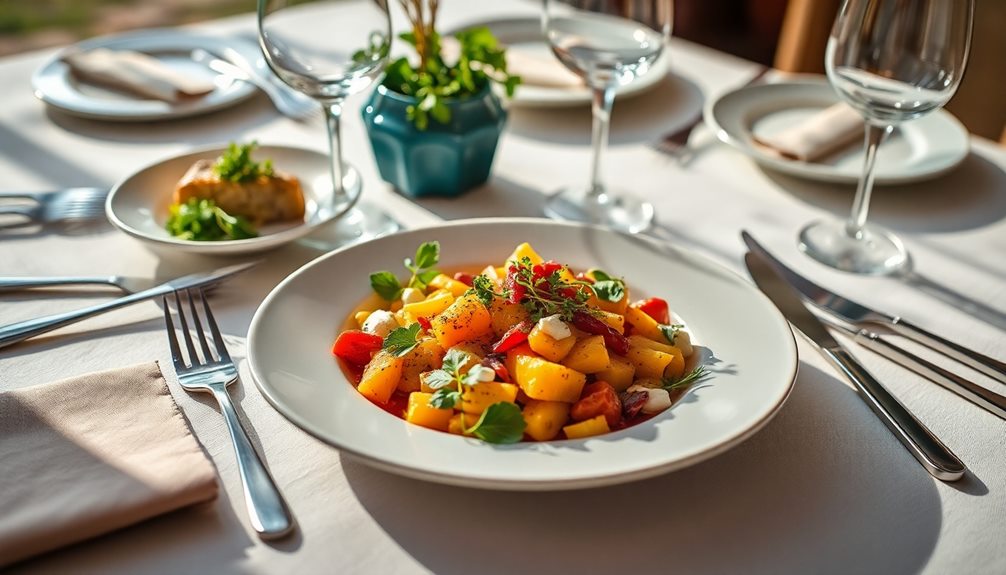
Capturing stunning food images goes beyond just having the right equipment; how you style the food plays an essential role in the final result. To elevate your food photos, start by using fresh ingredients and vibrant garnishes. These elements can enhance the visual appeal and boost viewer engagement by up to 60% on social media platforms.
When you arrange food, consider odd-numbered groupings or triangular formations. These compositions are often more visually appealing and can attract more attention from potential customers. Make sure your plates are clean and polished; using tools like tweezers can help you place items with precision, making your images look professional.
Incorporating contrasting colors and textures adds depth and interest to your food styling. Dishes with varied colors are more likely to catch the audience's eye.
Additionally, utilize props that complement the dish without overshadowing it. A well-styled environment can enhance storytelling and convey a cohesive brand identity, ultimately increasing customer recognition.
Incorporating Human Elements
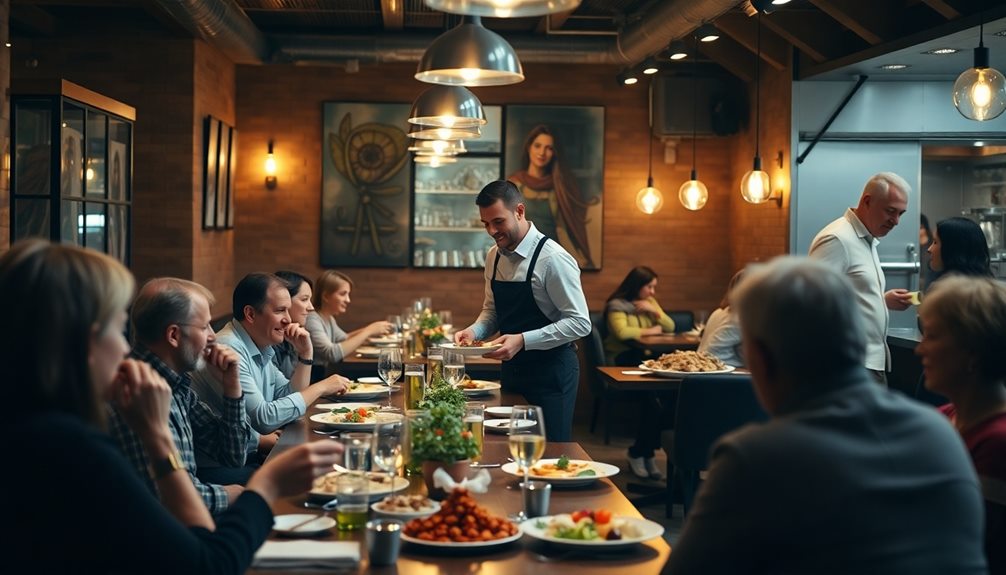
Incorporating human elements into food photography brings warmth and relatability to your images, making them more inviting and engaging for viewers.
When you add a human touch during your restaurant shoots, you create beautiful photos that resonate with potential customers.
Here are some effective ways to incorporate human elements:
- Capture Action: Snap shots of diners enjoying their meals or reaching for dishes. These moments evoke emotions and tell a story.
- Highlight the Chefs: Candid shots of chefs preparing food or serving dishes emphasize the culinary craftsmanship behind the restaurant's offerings.
- Dynamic Movement: Action shots, like pouring drinks or cutting into a dish, add excitement and capture attention, enhancing the visual interest of your food images.
Research shows that images featuring people tend to receive higher engagement rates on social media, leading to increased shares and visibility for the restaurant.
Editing and Post-Processing
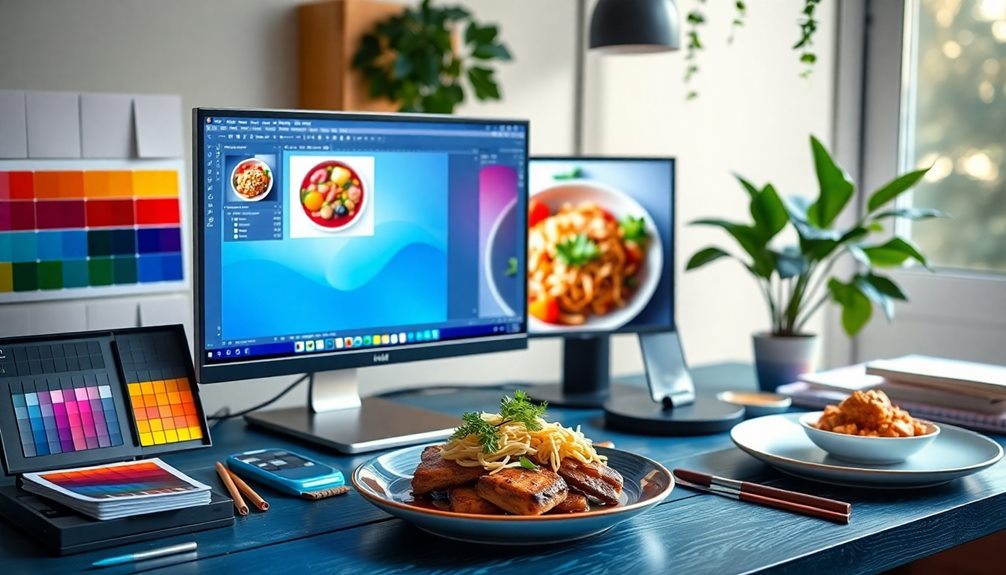
Editing and post-processing are essential steps in elevating your restaurant photography. They enhance your images by adjusting brightness, contrast, and color correction, ensuring the food looks true to life and visually appealing.
Start by cropping your photos; removing distractions can greatly improve composition and focus attention on the dish, enhancing the overall impact.
Utilize software like Adobe Lightroom or Photoshop to apply advanced editing techniques. You can sharpen details, correct exposure issues, and adjust colors to create a polished final product that draws customers in.
Consistency in your editing style across your portfolio not only reinforces your brand identity but also makes your images easily recognizable to potential diners.
Frequently Asked Questions
What Are the Best Settings for Restaurant Photography?
For restaurant photography, you'll want a low aperture for depth, an ISO of 100-800, and a shutter speed of at least 1/60s. Experiment with white balance and always shoot in RAW for quality.
How to Take a Photo for a Restaurant?
Imagine capturing that perfect shot of a mouthwatering pasta, sunlight streaming through the window. To take a photo for a restaurant, use natural light, experiment with angles, and style the dish beautifully for maximum impact.
How to Shoot Content for a Restaurant?
When you shoot content for a restaurant, plan your shots, utilize natural light, experiment with different angles, and incorporate complementary props. Communicate clearly with the staff to guarantee a smooth and efficient shooting process.
How to Photograph Food Professionally?
To photograph food professionally, use natural light near windows, experiment with different angles, apply the rule of thirds, invest in a good camera, and consistently edit for brightness and color to enhance your images.
Conclusion
In the delightful world of food photography, capturing mouthwatering moments isn't just about snapping a picture; it's about weaving a visual story that tempts the taste buds. By employing these tips, you'll elevate your skills and transform ordinary meals into extraordinary memories. Remember, every plate has a tale to tell, so let your creativity flourish and savor the journey. With a little practice and passion, you'll make every dish shine brighter than a Michelin star!
